251 books about Chicago (Ill.) and 5
start with U
251 books about Chicago (Ill.) and 5
251 books about Chicago (Ill.)
5 start with U start with U
5 start with U start with U
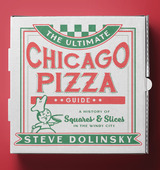
The Ultimate Chicago Pizza Guide
A History of Squares & Slices in the Windy City
Steve Dolinsky
Northwestern University Press, 2021
The Ultimate Chicago Pizza Guide is your comprehensive guide to the history of the styles, locales, and people that make the Windy City a prime destination for slices and pies. Most locals have strong opinions about whether thin, tavern-style, or deep-dish takes the crown, which toppings are essential, and who makes the best pie in town—and in Chicago, there's a destination for every preference. During the COVID-19 pandemic, Chicago saw an unprecedented number of new pizzerias opening their doors, very few of which focused on the proverbial deep-dish. Several high-end chefs made the pivot to pizza, and in many cases, brought new ideas and styles, like East Coast Sicilians and thin, crispy (and cheeseless) Roman pies. With so many slices to try in the city’s seventy-seven neighborhoods, it would seem impossible to find the best of the best.
Enter renowned food journalist Steve Dolinsky. He embarked on a memorable quest for his first book, Pizza City, USA: 101 Reasons Why Chicago Is America’s Greatest Pizza Town, tasting more than 185 pizzas all over the region. For his follow-up, Dolinsky focuses on the city’s pizzerias, while still honoring a few suburban stalwarts.
This user-friendly guide is organized by pizza style—including thin, tavern, artisan, Neapolitan, deep-dish, stuffed, by-the-slice, Roman, and Detroit—so you can find the right recommendation for every family member, visitor, and occasion. Dolinsky highlights his favorites, offers a pizza lover’s glossary so you can order like a pro, and shows you every pie he ate, so you can compare notes and cook up your next pizza night. With recipes, local beer pairings, gluten-free options, and more, The Ultimate Chicago Pizza Guide is an essential resource both for locals and for visitors in search of a serious pizza getaway.
Enter renowned food journalist Steve Dolinsky. He embarked on a memorable quest for his first book, Pizza City, USA: 101 Reasons Why Chicago Is America’s Greatest Pizza Town, tasting more than 185 pizzas all over the region. For his follow-up, Dolinsky focuses on the city’s pizzerias, while still honoring a few suburban stalwarts.
This user-friendly guide is organized by pizza style—including thin, tavern, artisan, Neapolitan, deep-dish, stuffed, by-the-slice, Roman, and Detroit—so you can find the right recommendation for every family member, visitor, and occasion. Dolinsky highlights his favorites, offers a pizza lover’s glossary so you can order like a pro, and shows you every pie he ate, so you can compare notes and cook up your next pizza night. With recipes, local beer pairings, gluten-free options, and more, The Ultimate Chicago Pizza Guide is an essential resource both for locals and for visitors in search of a serious pizza getaway.
[more]
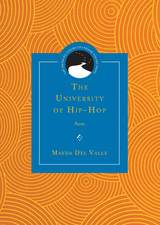
The University of Hip-Hop
Poems
Mayda Del Valle, foreword by Chris Abani
Northwestern University Press, 2017
The University of Hip-Hop is a love letter to the city of Chicago, or, more specifically, to Chicago at a particular moment in the poet's life. It is a meditation on movement and migration that asks what it means to leave home, how to take home with you, and how to build a new home elsewhere. These poems invoke nostalgia tempered with the knowledge that one cannot return to the past. They employ tonal and structural variations that account for said nostalgia without risking naïveté, taking all the influence of that time (hope, youth, love, music, art, and engagement) as a formal device, yet one filtered through the condensation of a current, more mature and nuanced understanding. The worldview learned then is employed in the now and frames the approach to the work, moving through formal registers that include spoken word, American lyric and narrative traditions, experimental thrusts, and documentary honed with the edge of hip-hop.
[more]
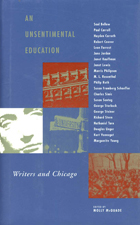
An Unsentimental Education
Writers and Chicago
Molly McQuade
University of Chicago Press, 1995
"Writers are both born and made, and their teachers share in the making of them, but in what ways?" Molly McQuade asks in An Unsentimental Education, a collection of candid interviews with twenty-one of our leading novelists and poets. Presented as first-person essays, the interviews are with contemporary writers who have studied, taught at, or cultivated other ties with the University of Chicago. The book provides an occasion for the writers to reflect on their Chicago experiences and on ideas about education in general. What education does a writer need? How can formal learning impel the writing life? What school stories or tales told out of school do Philip Roth, Hayden Carruth, Marguerite Young, George Steiner, Charles Simic, Susan Sontag, and Saul Bellow have in store and want to share.
Interviews with:Saul Bellow, Paul Carroll, Hayden Carruth, Robert Coover, Leon Forrest, June Jordan, Janet Kauffman, Morris Philipson, M. L. Rosenthal, Philip Roth, Susan Fromberg Shaeffer, Charles Simic, Susan Sontag, George Starbuck, George Steiner, Richard Stern, Nathaniel Tarn, Douglas Unger, Kurt Vonnegut, and Marguerite Young.
Interviews with:Saul Bellow, Paul Carroll, Hayden Carruth, Robert Coover, Leon Forrest, June Jordan, Janet Kauffman, Morris Philipson, M. L. Rosenthal, Philip Roth, Susan Fromberg Shaeffer, Charles Simic, Susan Sontag, George Starbuck, George Steiner, Richard Stern, Nathaniel Tarn, Douglas Unger, Kurt Vonnegut, and Marguerite Young.
[more]
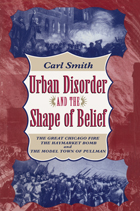
Urban Disorder and the Shape of Belief
The Great Chicago Fire, the Haymarket Bomb, and the Model Town of Pullman
Carl Smith
University of Chicago Press, 1994
The Great Chicago Fire of 1871, the Haymarket bombing of 1886, and the making and unmaking of the model town of Pullman—these remarkable events in what many considered the quintessential American city forced people across the country to confront the disorder that seemed inevitably to accompany urban growth and social change. In this book, Carl Smith explores the imaginative dimensions of these events as he traces the evolution of beliefs that increasingly linked city, disorder, and social reality in the minds of Americans. Studying a remarkable range of writings and illustrations, as well as protests, public gatherings, trials, hearings, and urban reform and construction efforts, Smith argues that these three events—and the public awareness of the them—not only informed one another, but collectively shaped how Americans saw, and continue to see, the city.
[more]
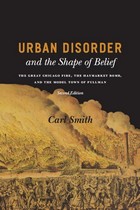
Urban Disorder and the Shape of Belief
The Great Chicago Fire, the Haymarket Bomb, and the Model Town of Pullman, Second Edition
Carl Smith
University of Chicago Press, 2007
The Great Chicago Fire of 1871, the Haymarket bombing of 1886, and the making and unmaking of the model town of Pullman—these remarkable events in what many considered the quintessential American city forced people across the country to confront the disorder that seemed inevitably to accompany urban growth and social change.
In Urban Disorder and the Shape of Belief, Carl Smith explores the imaginative dimensions of these events as he traces the evolution of interconnected beliefs and actions that increasingly linked city, disorder, and social reality in the minds of Americans. Examining a remarkable range of writings and illustrations, as well as protests, public gatherings, trials, hearings, and urban reform and construction efforts, Smith argues that these three events—and the public awareness of them—not only informed one another, but collectively shaped how Americans understood, and continue to understand, Chicago and modern urban life.
This classic of urban cultural history is updated with a foreword by the author that expands our understanding of urban disorder to encompass such recent examples as Hurricane Katrina, the Oklahoma City Bombing, and 9/11.
“Cultural history at its finest. By utilizing questions and methodologies of urban studies, social history, and literary history, Smith creates a sophisticated account of changing visions of urban America.”—Robin F. Bachin, Journal of Interdisciplinary History
In Urban Disorder and the Shape of Belief, Carl Smith explores the imaginative dimensions of these events as he traces the evolution of interconnected beliefs and actions that increasingly linked city, disorder, and social reality in the minds of Americans. Examining a remarkable range of writings and illustrations, as well as protests, public gatherings, trials, hearings, and urban reform and construction efforts, Smith argues that these three events—and the public awareness of them—not only informed one another, but collectively shaped how Americans understood, and continue to understand, Chicago and modern urban life.
This classic of urban cultural history is updated with a foreword by the author that expands our understanding of urban disorder to encompass such recent examples as Hurricane Katrina, the Oklahoma City Bombing, and 9/11.
“Cultural history at its finest. By utilizing questions and methodologies of urban studies, social history, and literary history, Smith creates a sophisticated account of changing visions of urban America.”—Robin F. Bachin, Journal of Interdisciplinary History
[more]
READERS
Browse our collection.
PUBLISHERS
See BiblioVault's publisher services.
STUDENT SERVICES
Files for college accessibility offices.
UChicago Accessibility Resources
home | accessibility | search | about | contact us
BiblioVault ® 2001 - 2024
The University of Chicago Press









